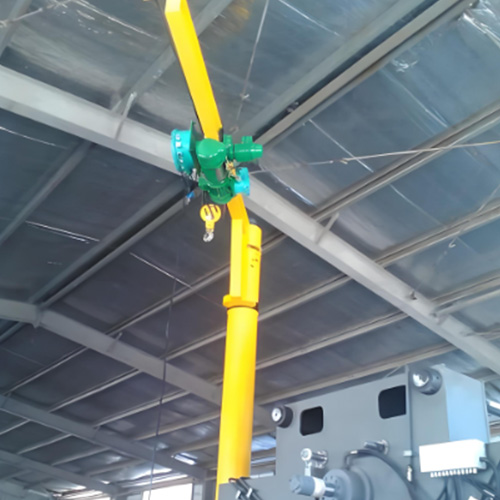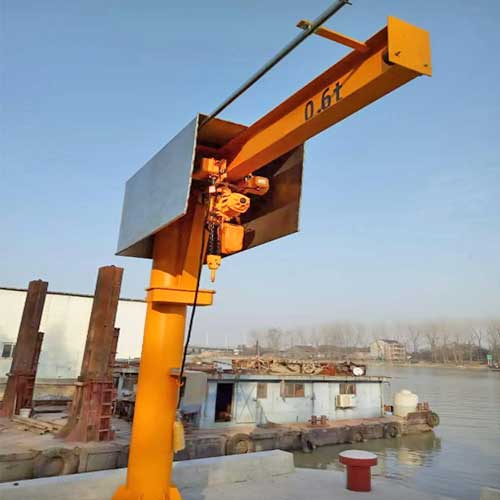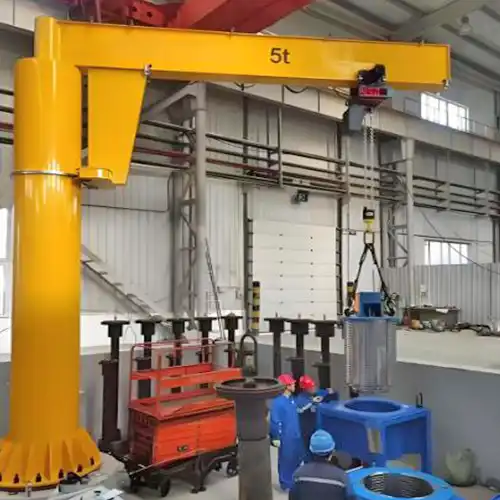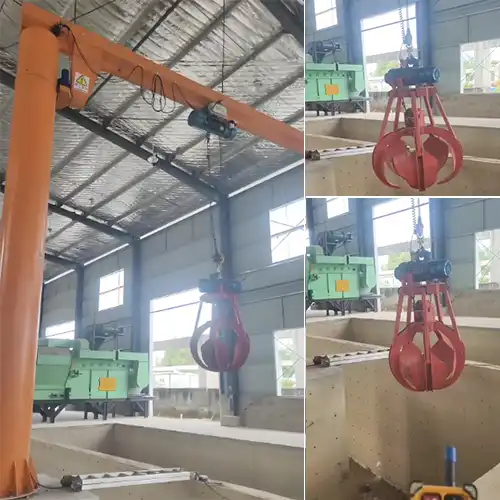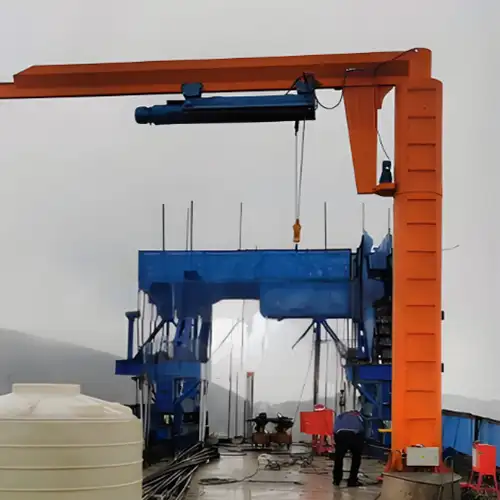Explosion-Proof 5 Ton Jib Cranes for Hazardous Environments
Explosion-proof 5 ton jib cranes for reliable & safe lifting in hazardous environments, ensuring protection & efficiency in potentially explosive settings.
Category: Jib Crane Capacity & Tonnages
Your Trusted Jib Crane Manufacturer & Supplier
Explosion-Proof 5 Ton Jib Cranes for Hazardous Environments
Explosion-proof 5 ton jib cranes for reliable & safe lifting in hazardous environments, ensuring protection & efficiency in potentially explosive settings.
5 Ton Jib Cranes Ensuring Safety in Hazardous Environments:
In hazardous environments, jib cranes, especially 5 ton ones, are indispensable. These robust machines not only help lift and move heavy loads but also play a crucial role in ensuring safety. In environments where risks are high, like hazardous settings, the design and features of these cranes can mean the difference between a safe workplace and a potential disaster.
Now, let's to explore the advanced safety features of 5 ton jib cranes designed for hazardous environments. We'll delve into the importance of safety in industrial settings and examine the specialized design of these cranes.
Industrial Hazardous Environments
In the various working environment of various industrial workshops, certain environments present unique challenges and risks that demand heightened attention to safety protocols. These are what we classify as hazardous environments, where the presence of flammable gases, combustible dust, corrosive chemicals, or other volatile substances significantly increases the potential for accidents and injuries.
Definition and Classification
Hazardous environments encompass a broad spectrum of settings, ranging from chemical plants and oil refineries to grain silos and manufacturing facilities. These areas are typically categorized based on the type of hazards present, such as:
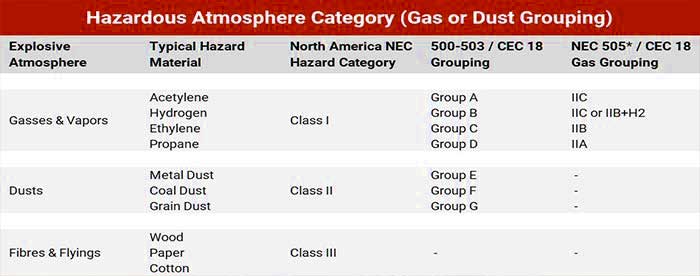
- Explosive Atmospheres: Locations where flammable gases, vapors, or combustible dust mix with air in proportions that can ignite and cause explosions.
- Corrosive Environments: Areas where exposure to corrosive substances, such as acids or alkalis, can deteriorate materials and compromise structural integrity.
- Confined Spaces: Enclosed or partially enclosed spaces with limited entry and exit points, posing risks of asphyxiation, engulfment, or exposure to hazardous atmospheres.
Risks and Challenges
Operating cranes in hazardous environments amplifies the inherent risks associated with lifting and maneuvering heavy loads. Some of the key challenges include:
- Ignition Hazards: The presence of flammable gases or dust particles increases the risk of ignition during crane operations, potentially leading to explosions or fires.
- Corrosion Damage: Exposure to corrosive substances can accelerate the deterioration of crane components, compromising their structural integrity and safety.
- Limited Visibility: Poor lighting conditions or the presence of obstructive materials may hinder visibility, increasing the likelihood of accidents or collisions.
- Confined Space Hazards: Maneuvering cranes in confined spaces presents risks of entrapment, as well as challenges in accessing and evacuating personnel in case of emergencies.
Importance of Specialized Safety Measures
Given the heightened risks associated with hazardous environments, implementing specialized safety measures is paramount to mitigating potential hazards and ensuring the well-being of workers. These measures may include:
- Explosion-Proof Design: Cranes engineered with explosion-proof features, such as sealed enclosures and spark-resistant components, minimize the risk of igniting flammable atmospheres.
- Corrosion Resistance: The use of corrosion-resistant materials and protective coatings helps safeguard crane structures against chemical deterioration, prolonging their lifespan and reliability.
- Enhanced Visibility: Installing adequate lighting and incorporating visibility aids, such as cameras or warning systems, improves operator awareness and reduces the likelihood of accidents.
- Training and Procedures: Providing comprehensive training to crane operators and implementing strict safety procedures for working in hazardous environments fosters a culture of safety awareness and compliance.
In essence, recognizing the unique challenges of hazardous environments and implementing tailored safety measures are essential steps in safeguarding personnel and equipment during crane operations. By understanding the risks and embracing proactive safety practices, industries can navigate these environments with confidence and peace of mind.
Overview of 5 Ton Jib Cranes in Hazardous Environments
In material handling, jib cranes stand out as versatile and reliable solutions for lifting and moving heavy loads within a limited radius. Among these stalwart workhorses, the 5 ton jib crane occupies a prominent position, offering robust performance and flexibility tailored to the demands of various industrial applications.
Jib cranes are a type of overhead lifting equipment characterized by their horizontal jib or boom, which can rotate to provide coverage within a specific area. The primary components of a jib crane include:
- Boom: The horizontal arm of the crane that extends from the mast or vertical support structure.
- Hoist: The lifting mechanism attached to the end of the boom, used to raise and lower loads.
- Rotation Mechanism: Allows the boom to rotate horizontally, providing 360-degree coverage.
- Support Structure: Provides stability and support for the crane, typically mounted to a floor, wall, or column.
The basic functionality of a jib crane involves positioning the load beneath the hoist, lifting it using the hoisting mechanism, and then moving it horizontally within the crane's operational radius.

Explosion proof jib crane
Common Applications and Industries
Hazardous environment jib cranes find application across various industrial workshops where the presence of flammable gases, combustible dust, corrosive chemicals, or other volatile substances poses risks to personnel and equipment. Some typical workshops where these cranes are used include:
- Chemical Manufacturing Plants: Chemical manufacturing plants handle hazardous materials and substances that can be flammable, corrosive, or toxic. Hazardous environment jib cranes are essential for lifting and moving chemical containers, raw materials, and equipment within these facilities.
- Oil Refineries: Oil refineries process crude oil into various petroleum products, exposing workers to flammable gases, vapors, and other hazards. Safe jib cranes are required for maintenance, repair, and material handling tasks in areas with potential ignition sources and combustible atmospheres.
- Petrochemical Facilities: Petrochemical facilities produce a wide range of chemicals and derivatives from petroleum and natural gas. Hazardous environment jib cranes are used for handling drums, barrels, and containers of hazardous chemicals, as well as for maintenance activities in corrosive environments.
- Pharmaceutical Laboratories: Pharmaceutical laboratories handle hazardous substances and materials used in drug manufacturing processes. Safe jib cranes are necessary for lifting and moving chemical reagents, laboratory equipment, and pharmaceutical products while minimizing the risk of contamination or exposure.
- Food Processing Plants: Food processing plants operate in environments where the presence of dust, moisture, and organic materials poses risks of contamination and bacterial growth. Hazardous environment jib cranes are employed for lifting and transporting heavy equipment, packaging materials, and bulk ingredients while adhering to strict hygiene standards.
Safe jib cranes are required in each of these different industrial workshops for several reasons:
- Protection of Personnel: Safe jib cranes help minimize the risk of accidents, injuries, and fatalities by incorporating specialized safety features such as explosion-proof construction, corrosion-resistant materials, and operator safeguards. - Preservation of Assets: Safe jib cranes safeguard valuable equipment, machinery, and materials from damage caused by explosions, fires, corrosive substances, or mishandling during lifting and handling operations.
- Compliance with Regulations: Safe jib cranes ensure compliance with regulatory requirements and standards, such as ATEX and NEMA, which mandate the use of certified equipment in hazardous environments to protect workers and the environment.
Typical Features of Hazardous Environment Jib Cranes:
Explosion-Proof Construction:
Hazardous environment jib cranes are designed with explosion-proof construction to mitigate the risk of igniting flammable gases or vapors present in the atmosphere. This involves:
- Sealed Enclosures: Critical electrical components, such as motors, switches, and wiring, are housed within sealed enclosures to prevent sparks or arcs from escaping and coming into contact with hazardous substances.
- Spark-Resistant Materials: Components exposed to friction or mechanical stress are fabricated from spark-resistant materials such as bronze, brass, or stainless steel to eliminate the risk of generating sparks that could ignite flammable atmospheres.
Corrosion-Resistant Materials and Coatings:
Given the corrosive nature of many hazardous environments, jib cranes are constructed using corrosion-resistant materials and coatings to withstand exposure to corrosive chemicals and environments. This includes:
- Stainless Steel Components: Critical crane components are fabricated from stainless steel, known for its exceptional corrosion resistance, to ensure longevity and reliability in harsh conditions.
- Protective Coatings: Surfaces exposed to corrosive substances are coated with protective finishes such as epoxy or polyurethane coatings to create a barrier against chemical degradation and maintain structural integrity over time.
Overload Protection Systems:
To prevent crane overloading and ensure safe lifting capacities, hazardous environment jib cranes are equipped with overload protection systems. These systems include:
- Load Sensors: Sensors integrated into the crane's lifting mechanism detect changes in load weight and provide real-time feedback to the crane's control system.
- Automatic Shut-Off: When the load exceeds the crane's rated capacity, the overload protection system automatically shuts off power to the hoist motor, preventing overloading and potential accidents.
Remote Control Operation:
Remote control operation enhances operator safety and convenience by allowing operators to control crane movements from a safe distance. This feature includes:
- Wireless Remote Control: Operators can remotely control crane movements, including lifting, lowering, and slewing, using a handheld wireless remote control device.
- Emergency Stop Function: The remote control device is equipped with an emergency stop button that allows operators to immediately halt crane operations in case of emergencies or safety hazards.
By incorporating these advanced features, hazardous environment jib cranes ensure safe and efficient material handling operations in challenging industrial settings, minimizing the risk of accidents and ensuring the well-being of personnel.
Typical ObjectsHandled by Hazardous Environment Jib Cranes include:
Absolutely, let's expand on the typical objects handled by hazardous environment jib cranes:
- Chemical Drums, Barrels, and Containers: Hazardous environment jib cranes are often utilized for lifting and moving chemical drums, barrels, and containers containing various hazardous substances. These may include flammable liquids, corrosive chemicals, or toxic materials commonly found in industrial settings such as chemical manufacturing plants or petrochemical facilities.
- Heavy Machinery and Equipment: Jib cranes in hazardous environments are also tasked with lifting and positioning heavy machinery and equipment. This can include components for maintenance, repair, or installation within facilities such as oil refineries, where large-scale machinery is common and requires precise handling to prevent accidents or damage.
- Pallets of Raw Materials or Finished Products: In manufacturing environments, hazardous environment jib cranes are employed to lift and transport pallets containing raw materials or finished products. These may include palletized goods such as metal ingots, chemical powders, or industrial equipment parts, which need to be moved safely and efficiently within the facility.
- Laboratory Apparatus and Glassware: Within pharmaceutical laboratories or research facilities, jib cranes are utilized for handling delicate laboratory apparatus and glassware. This includes items such as beakers, test tubes, and scientific instruments, which require precise and gentle handling to prevent breakage or contamination.
- Packaging Materials and Bulk Ingredients: Hazardous environment jib cranes are also tasked with lifting and transporting packaging materials and bulk ingredients used in manufacturing processes. This may include materials such as bags of chemicals, sacks of flour or grains, or bulk containers of liquids, which need to be safely maneuvered to production lines or storage areas.
By handling these typical objects with precision and care, hazardous environment jib cranes play a vital role in ensuring efficient material handling operations while maintaining safety standards in challenging industrial environments.
Importance of Safety Considerations
Safety lies at the core of jib crane design and operation, particularly in hazardous environments where risks are heightened. Vital aspects of ensuring safety in jib crane operations include:
- Structural Integrity: Guaranteeing that the crane and its components are robust enough to endure the strain of lifting heavy loads without compromise. This ensures reliability and reduces the risk of structural failure during operations.
- Load Capacity: Adhering strictly to the crane's rated load capacity to prevent overloading, which can lead to structural damage or accidents. Respecting these limits ensures safe operations and extends the crane's lifespan.
- Operator Training: Providing thorough training to crane operators is essential for safe and efficient operation. Operators need to be well-versed in proper load handling techniques, as well as equipped with the awareness and skills to identify and mitigate potential hazards.
- Maintenance and Inspections: Implementing regular maintenance schedules and conducting thorough inspections are crucial for identifying and rectifying any issues that could compromise crane safety. Proactive maintenance ensures that the crane remains in optimal condition, reducing the likelihood of accidents or failures during operation.
By placing a premium on safety considerations throughout the design and use of 5 ton jib cranes, industries can significantly enhance workplace safety. Prioritizing safety not only protects personnel and equipment but also fosters a culture of responsibility and accountability in the workplace, ensuring that operations run smoothly and safely.
Explosion Proof Jib Cranes
Explosion-proof jib cranes are crucial assets in hazardous environments where the presence of flammable gases, vapors, or combustible dust poses significant safety risks. These specialized cranes are designed and constructed to minimize the risk of ignition and prevent the propagation of explosions, ensuring the safety of personnel and equipment in challenging industrial settings.
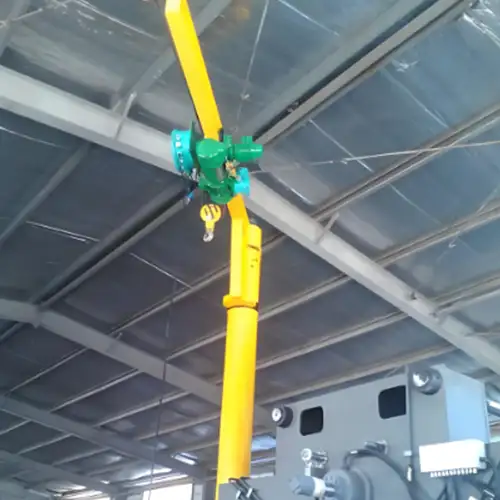
Key Features of Explosion-Proof Jib Cranes:
- Enclosed Components: Critical electrical and mechanical components, including motors, switches, and wiring, are enclosed within sealed housings to prevent sparks or arcs from igniting flammable substances in the surrounding atmosphere.
- Explosion-Resistant Construction: The crane's structural components are constructed using robust materials capable of withstanding internal explosions without rupturing or releasing hazardous substances. This includes reinforced steel frames and explosion-resistant enclosures for electrical components.
- Pressure Relief Mechanisms: In the event of an explosion, pressure relief mechanisms such as explosion vents or flame arrestors are integrated into the crane's design to safely vent excess pressure and prevent catastrophic damage to the crane and surrounding infrastructure.
- Non-Sparking Materials: Components exposed to friction or mechanical stress, such as bearings and fasteners, are fabricated from non-sparking materials such as bronze, brass, or stainless steel to eliminate the risk of generating sparks that could ignite flammable gases or vapors.
- Corrosion-Resistant Coatings: Surfaces exposed to corrosive environments are coated with protective finishes such as epoxy or polyurethane coatings to prevent corrosion-induced damage and maintain structural integrity over time.
- Certifications: Explosion-proof jib cranes undergo rigorous testing and certification processes to ensure compliance with industry standards and regulations, such as ATEX (ATmosphères EXplosibles) or NEMA (National Electrical Manufacturers Association) standards, which establish requirements for equipment used in potentially explosive atmospheres.
Specialized Safety Features
In hazardous environments where the risk of explosions and fires looms large, the design and construction of 5 ton jib cranes must incorporate specialized safety features to mitigate these risks effectively.
Explosion-Proof Construction
Explosion-proof jib cranes are engineered to minimize the risk of igniting flammable gases, vapors, or combustible dust present in the surrounding atmosphere. The principles behind their design focus on containing potential ignition sources and preventing the propagation of explosions.
Explanation of Explosion-Proof Design Principles
Explosion-proof jib cranes adhere to stringent design standards aimed at preventing sparks, arcs, or hot surfaces from igniting flammable substances. Key design principles include:
- Enclosed Components: Critical electrical and mechanical components, such as motors, switches, and wiring, are housed within sealed enclosures to prevent sparks or arcs from escaping.
- Explosion-Resistant Construction: Crane components are constructed using robust materials capable of withstanding internal explosions without rupturing or releasing hazardous substances.
- Pressure Relief Mechanisms: In the event of an explosion, pressure relief mechanisms, such as explosion vents or flame arrestors, are incorporated to safely vent excess pressure and prevent catastrophic damage.
- Intrinsic Safety Measures: Electrical systems are designed to operate at low voltages and currents, reducing the risk of sparking and minimizing the potential for ignition.
Materials and Construction Techniques Used to Prevent Ignition Sources
To minimize the risk of ignition sources and enhance the safety of explosion-proof jib cranes, specific materials and construction techniques are employed:
- Non-Sparking Materials: Components exposed to friction or mechanical stress, such as bearings and fasteners, are fabricated from non-sparking materials like bronze, brass, or stainless steel to eliminate the risk of generating sparks.
- Corrosion-Resistant Coatings: Surfaces exposed to corrosive environments are coated with protective finishes, such as epoxy or polyurethane coatings, to prevent corrosion-induced damage and maintain structural integrity.
- Sealed Enclosures: Electrical enclosures are hermetically sealed to prevent the ingress of dust, moisture, or corrosive agents, minimizing the risk of electrical faults and ensuring the reliability of critical components.
By incorporating these specialized safety features, explosion-proof jib cranes provide a robust solution for material handling in hazardous environments, offering peace of mind to operators and mitigating the risk of catastrophic accidents. Their design reflects a commitment to prioritizing safety without compromising functionality or efficiency, making them indispensable assets in industries where safety is paramount.

Explosion proof hoist for jib cranes

Electric motor driven rotating jib crane

Reliable free standing pillar mounted jib crane
Corrosion-Resistant Materials
In hazardous environments, where corrosive substances abound and exposure to harsh conditions is inevitable, the incorporation of corrosion-resistant materials in the construction of 5 ton jib cranes is paramount to ensuring their longevity, reliability, and safety.
Importance of Corrosion Resistance in Hazardous Environments
Corrosion, the gradual deterioration of materials due to chemical reactions with the environment, poses significant challenges in industrial settings. In hazardous environments, where corrosive substances such as acids, alkalis, or salts are prevalent, the impact of corrosion is exacerbated. The importance of corrosion resistance in crane construction cannot be overstated for several reasons:
- Structural Integrity: Corrosion weakens materials over time, compromising the structural integrity of crane components and increasing the risk of catastrophic failures during operation.
- Safety Concerns: Corroded parts or components may fail unexpectedly, leading to accidents, injuries, or damage to property.
- Operational Efficiency: Corrosion-induced degradation can impair the performance and functionality of cranes, resulting in downtime, decreased productivity, and increased maintenance costs.
By utilizing corrosion-resistant materials and coatings, crane manufacturers can mitigate these risks, prolonging the service life of jib cranes and ensuring their safe and efficient operation in hazardous environments.
Types of Materials Used for Corrosion Resistance in Crane Construction
A variety of materials and coatings are employed to enhance corrosion resistance in crane construction, each offering unique advantages in terms of durability, performance, and cost-effectiveness:
- Stainless Steel: Renowned for its exceptional corrosion resistance, stainless steel is a preferred choice for critical crane components exposed to corrosive environments. Its alloy composition, which includes chromium, nickel, and molybdenum, forms a passive oxide layer that protects against rust and corrosion.
- Galvanized Steel: Galvanization involves coating steel components with a layer of zinc to provide a sacrificial barrier against corrosion. Galvanized cranes exhibit excellent resistance to atmospheric corrosion, making them suitable for outdoor applications exposed to moisture and environmental pollutants.
- Epoxy Coatings: Epoxy coatings offer an effective protective barrier against chemical exposure and corrosion. Applied as a durable film over metal surfaces, epoxy coatings provide superior adhesion and resistance to abrasion, chemicals, and moisture, extending the lifespan of crane components in aggressive environments.
- Polyurethane Coatings: Polyurethane coatings provide robust protection against corrosion, abrasion, and UV exposure. Formulated with polymeric resins and additives, polyurethane coatings offer exceptional durability and flexibility, making them ideal for crane components subjected to heavy wear and tear.
By selecting appropriate corrosion-resistant materials and coatings based on the specific environmental conditions and performance requirements, crane manufacturers can ensure the longevity, reliability, and safety of 5 ton jib cranes in hazardous environments. These proactive measures not only minimize maintenance costs and downtime but also uphold workplace safety standards and regulatory compliance, fostering a culture of responsibility and reliability in industrial operations.
Certifications and Compliance
In hazardous environments where the risks of accidents and emergencies are heightened, adherence to stringent safety regulations and standards is essential to safeguarding personnel, equipment, and the surrounding environment. Certifications such as ATEX and compliance with NEMA standards play a pivotal role in ensuring the integrity and safety of 5 ton jib cranes operating in such challenging conditions.
Overview of ATEX and NEMA Standards
- ATEX Standards: ATEX (ATmosphères EXplosibles) is a European regulatory framework that sets standards for equipment and protective systems intended for use in potentially explosive atmospheres. The ATEX directive encompasses two directives: ATEX 95, which concerns the safety of equipment intended for use in explosive atmospheres, and ATEX 137, which addresses the safety of workers in such environments. ATEX-certified equipment, including jib cranes, undergoes rigorous testing and certification processes to ensure compliance with specified safety requirements and criteria.
- NEMA Standards: The National Electrical Manufacturers Association (NEMA) is an American organization that establishes standards for electrical equipment and systems. NEMA standards encompass a wide range of electrical products and components, including those designed for hazardous locations. NEMA ratings classify equipment based on its suitability for use in different environmental conditions, such as wet or corrosive environments, and provide guidelines for ensuring the safety and reliability of electrical installations.
Importance of Compliance with Safety Regulations for Hazardous Environments
Compliance with safety regulations and standards is of paramount importance for several reasons:
- Mitigating Risks: Safety regulations establish guidelines and requirements aimed at minimizing the risks associated with hazardous environments, including the potential for explosions, fires, and other safety hazards. Compliance with these regulations ensures that equipment, such as 5 ton jib cranes, is designed, manufactured, and operated in a manner that reduces the likelihood of accidents and injuries.
- Protecting Personnel and Assets: Adherence to safety regulations helps protect the well-being of workers and the integrity of industrial facilities. By implementing safety measures and using certified equipment, employers can reduce the risk of workplace accidents, injuries, and property damage, thereby safeguarding personnel and assets from harm.
- Legal Compliance and Liability: Non-compliance with safety regulations can have legal and financial consequences for businesses, including fines, penalties, and litigation. Ensuring compliance with regulatory requirements, such as ATEX and NEMA standards, helps mitigate legal risks and liabilities associated with safety violations, demonstrating a commitment to workplace safety and regulatory compliance.
- Enhancing Reputation and Trust: Demonstrating compliance with safety regulations and standards enhances the reputation and credibility of businesses within their respective industries. Compliance with recognized standards such as ATEX and NEMA signals a commitment to quality, safety, and professionalism, instilling confidence and trust among customers, stakeholders, and regulatory authorities.
In conclusion, compliance with safety regulations and standards, including ATEX and NEMA certifications, is essential for ensuring the safety, integrity, and reliability of 5 ton jib cranes operating in hazardous environments. By adhering to established safety guidelines and using certified equipment, businesses can mitigate risks, protect personnel and assets, and demonstrate their commitment to workplace safety and regulatory compliance.
Case Studies and Examples
Through case studies and examples, we explore how specialized safety features have contributed to accident prevention and enhanced workplace safety. Additionally, we compare different models or manufacturers, highlighting their safety features and certifications to provide valuable insights for businesses and industries operating in challenging conditions.
Applications of 5 Ton Jib Cranes
Case Study 1: Chemical Manufacturing Plant
- Description: A chemical manufacturing plant utilizes explosion proof 5 ton jib cranes for material handling operations in areas with potentially explosive atmospheres.
- Application: The jib cranes are employed for lifting and moving chemical containers, raw materials, and equipment within confined spaces and corrosive environments.
- Safety Features: Explosion-proof construction and corrosion-resistant materials ensure the integrity and reliability of the cranes, minimizing the risk of accidents and chemical spills.
Case Study 2: Oil Refinery
- Description: An oil refinery employs 5 ton jib cranes for maintenance and repair tasks in hazardous locations exposed to flammable gases and vapors.
- Application: The cranes are utilized for hoisting heavy equipment, replacing components, and performing inspections in areas with limited access and high risk of ignition.
- Safety Features: ATEX-certified jib cranes equipped with explosion-proof electrical components and galvanized steel structures withstand corrosive environments and ensure safe operations in potentially explosive atmospheres.
Impact of Specialized Safety Features on Workplace Safety
- Accident Prevention: The implementation of explosion-proof construction and corrosion-resistant materials in 5 ton jib cranes has significantly reduced the risk of accidents caused by sparks, corrosion-induced failures, and structural weaknesses.
- Improved Operator Safety: Enhanced visibility aids and safety interlocks prevent unauthorized access and alert operators to potential hazards, minimizing the risk of injuries and ensuring the safety of personnel working in close proximity to crane operations.
- Mitigation of Environmental Risks: By preventing spills and leaks of hazardous materials, explosion-proof jib cranes contribute to environmental protection efforts, reducing the impact of industrial operations on surrounding ecosystems.
Comparison of Different Models or Manufacturers
- Safety Features: Leading manufacturers of 5 ton jib cranes offer a range of safety features, including explosion-proof construction, corrosion-resistant materials, overload protection systems, and comprehensive operator training programs.
- Certifications: A comparison of different models or manufacturers highlights the importance of certifications such as ATEX and NEMA ratings, which provide assurance of compliance with industry standards and regulatory requirements.
- Cost vs. Benefit Analysis: While initial investment costs may vary between different models or manufacturers, the long-term benefits of enhanced safety, reliability, and compliance with safety regulations outweigh the upfront expenses.
Through the examination of case studies, analysis of safety features, and comparison of different models or manufacturers, businesses can make informed decisions when selecting 5 ton jib cranes for use in hazardous environments. Prioritizing safety considerations and investing in certified equipment contribute to accident prevention, workplace safety, and regulatory compliance, ultimately fostering a culture of safety and responsibility within industrial settings.
Conclusion
Safety is the cornerstone of industrial operations, especially in hazardous environments where the stakes are high and the risks are ever-present. In this concluding section, we recap the paramount importance of safety in industrial settings, summarize key findings regarding advanced safety features in 5 ton jib cranes, and reflect on the critical role of safety-centric design in ensuring workplace safety in hazardous environments.
Safety is not just a priority; it is a fundamental requirement in industrial settings where the well-being of workers, equipment, and the environment is at stake. From chemical plants to construction sites, adherence to strict safety protocols and regulations is imperative to prevent accidents, injuries, and disasters. Safety isn't just about compliance; it's about protecting lives, preserving assets, and fostering a culture of responsibility and accountability.
Through our exploration, we have uncovered the critical role of advanced safety features in 5 ton jib cranes designed for hazardous environments. These cranes are equipped with specialized features such as explosion-proof construction, corrosion-resistant materials, and compliance with stringent certifications like ATEX and NEMA standards. These features are not just enhancements; they are essential components that ensure the integrity, reliability, and safety of crane operations in challenging conditions.
Safety-centric design isn't just about meeting regulatory requirements or checking boxes; it's about designing and engineering solutions that prioritize the safety and well-being of everyone involved. In hazardous environments, where the risks are heightened and the consequences can be dire, safety cannot be an afterthought; it must be integrated into every aspect of crane design, operation, and maintenance. By embracing safety-centric design principles, industries can create safer work environments, minimize risks, and protect their most valuable assets—their people.
Related Products

Latest project
150 Ton Overhead Crane Installation Feedback – Paraguay Case
QDX 150 ton overhead crane in action in Paraguay. Installation photos, video, and client feedback show performance, safety, and heavy-lifting efficiency.
Free consultation to Confirm Parameters & Specifications and Get
Latest Crane Price & Crane Rate.
- Types of overhead cranes : _______?
- Optional: Overhead travelling crane, goliath gantry crane,Slewing jib crane, Single girder or double girder crane,small portable crane or kbk crane, etc.
- Capacity of overhead crane: _______?
- Optional: 0.25ton, 0.5 ton, 1 ton, 2 ton, 3ton, 5 ton, 10 ton,15ton, 20ton, 25 ton, 30ton,35ton, up to 550ton, etc.
- Crane span & lifting height : _______?
- Crane travelling length : _____?
- Control of overhead crane:_______?
- Optional: pendant/ remote/cabin control
- Voltage supply of overhead crane:_____?
- Eg,: 380V50/60HZ,3Phase or others,etc.
- Application/usage of crane:_______?
- Eg,: Steel mill, ,injection mold, cement,stone, concrete,granite, general manufacturing, etc.
Just leave a message via the contact form and our hoist and crane engineer will contact you with in 24working hours.
Get In Touch
